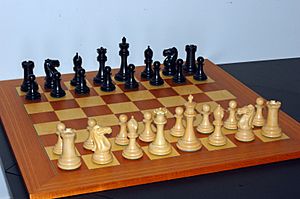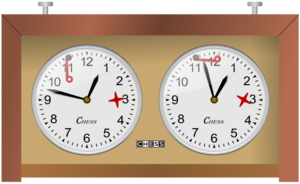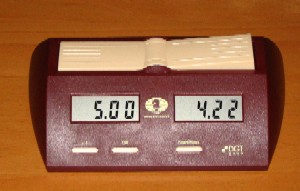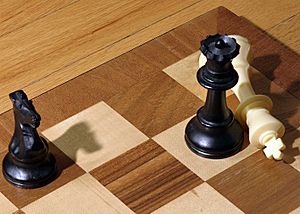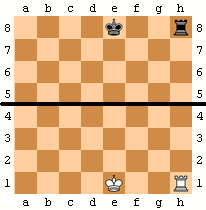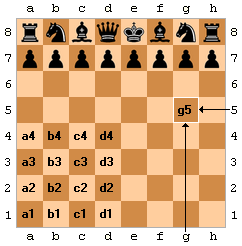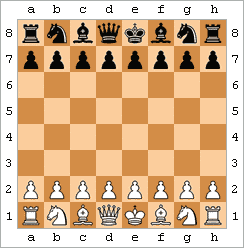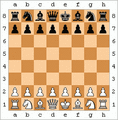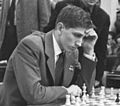Chess facts for kids
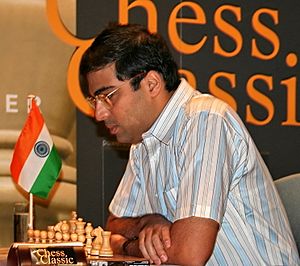
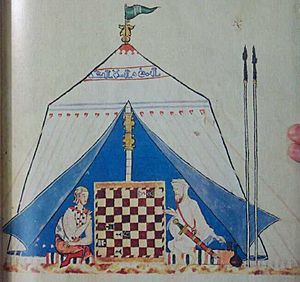
Chess is a board game for two players. It is played on a square board with 64 smaller squares. The board has eight squares on each side. Each player starts with sixteen pieces. These include eight pawns, two knights, two bishops, two rooks, one queen and one king.
The main goal of the game is to checkmate the opponent's king. Checkmate means the king is under attack ('check') and cannot escape. When a king is checkmated, the game ends.
During the game, players take turns moving one of their pieces. One player, called 'White', has light-colored pieces. The other player, 'Black', has dark-colored pieces. There are special rules for how each piece moves. There are also rules for taking an opponent's pieces off the board. White always makes the first move. This gives White a small advantage, so White often wins more games in tournaments.
Chess is very popular and is played in many countries. It is a national hobby in Russia. Magnus Carlsen is the current World Chess Champion. He won the title on November 22, 2013, by beating Viswanathan Anand. Carlsen also won their next match in 2014.
Contents
History of Chess
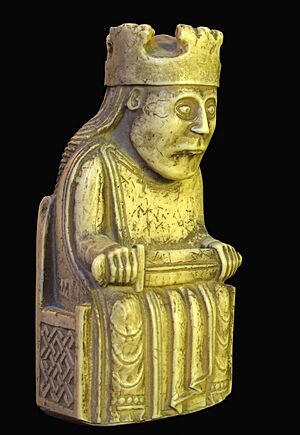
Most historians believe chess started in northern India. This was during the Gupta Empire in the 6th century AD. This early version of chess was called Chaturanga. This is a Sanskrit word meaning "military". The pieces in Gupta chess were like parts of an army: infantry, cavalry, elephants, and chariots. Over time, these became the pawn, knight, bishop, and rook. The English words chess and check come from the Persian word shāh, which means king.
The first written records of chess are from three epic stories in Sassanid Persia. These were written around 600 AD. The game was known as chatrang or shatranj. When Muslims took over Persia (633–644), they spread the game. Muslim traders carried chess to Russia and Western Europe. By the year 1000, it was played all over Europe. A Spanish book from the 13th century, Libro de los Juegos, describes shatranj (chess), backgammon, and dice.
The game changed a lot between 1470 and 1495. The rules for some pieces, like the queen and bishop, were changed. They could move much further. This made the game faster and more exciting. These new rules became the basis for modern international chess. Many chess historians think this was the most important change since chess was invented.
How to Play Chess
The rules of chess are set by the World Chess Federation. This group is known as FIDE, which stands for Fédération Internationale des Échecs. Their rules are in the Laws of Chess section of the FIDE Handbook. FIDE also has rules for chess tournaments.
Setting Up the Board
Chess is played on a square board. It has eight rows called ranks and eight columns called files. There are 64 squares in total. The squares are light and dark, like a checkerboard.
To make it easy to talk about moves, each square has a name. Ranks are numbered 1 to 8. Files are lettered a to h. So, every square has a unique label, like g1 or f5.
Players have white or black pieces. At the start, each player has 16 pieces:
- one king
- one queen
- two rooks
- two bishops
- two knights
- eight pawns
How Pieces Move
Each piece moves in its own special way.
- Vertical lines on the board are called files.
- Horizontal lines are called ranks.
- Lines at 45 degrees are called diagonals.
| a | b | c | d | e | f | g | h | ||
| 8 |
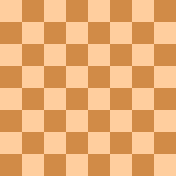
|
8 | |||||||
| 7 | 7 | ||||||||
| 6 | 6 | ||||||||
| 5 | 5 | ||||||||
| 4 | 4 | ||||||||
| 3 | 3 | ||||||||
| 2 | 2 | ||||||||
| 1 | 1 | ||||||||
| a | b | c | d | e | f | g | h | ||
| a | b | c | d | e | f | g | h | ||
| 8 |

|
8 | |||||||
| 7 | 7 | ||||||||
| 6 | 6 | ||||||||
| 5 | 5 | ||||||||
| 4 | 4 | ||||||||
| 3 | 3 | ||||||||
| 2 | 2 | ||||||||
| 1 | 1 | ||||||||
| a | b | c | d | e | f | g | h | ||
| a | b | c | d | e | f | g | h | ||
| 8 |

|
8 | |||||||
| 7 | 7 | ||||||||
| 6 | 6 | ||||||||
| 5 | 5 | ||||||||
| 4 | 4 | ||||||||
| 3 | 3 | ||||||||
| 2 | 2 | ||||||||
| 1 | 1 | ||||||||
| a | b | c | d | e | f | g | h | ||
| a | b | c | d | e | f | g | h | ||
| 8 |

|
8 | |||||||
| 7 | 7 | ||||||||
| 6 | 6 | ||||||||
| 5 | 5 | ||||||||
| 4 | 4 | ||||||||
| 3 | 3 | ||||||||
| 2 | 2 | ||||||||
| 1 | 1 | ||||||||
| a | b | c | d | e | f | g | h | ||
| a | b | c | d | e | f | g | h | ||
| 8 |

|
8 | |||||||
| 7 | 7 | ||||||||
| 6 | 6 | ||||||||
| 5 | 5 | ||||||||
| 4 | 4 | ||||||||
| 3 | 3 | ||||||||
| 2 | 2 | ||||||||
| 1 | 1 | ||||||||
| a | b | c | d | e | f | g | h | ||
| a | b | c | d | e | f | g | h | ||
| 8 |

|
8 | |||||||
| 7 | 7 | ||||||||
| 6 | 6 | ||||||||
| 5 | 5 | ||||||||
| 4 | 4 | ||||||||
| 3 | 3 | ||||||||
| 2 | 2 | ||||||||
| 1 | 1 | ||||||||
| a | b | c | d | e | f | g | h | ||
- The king (K) moves one square in any direction. The king cannot move to a square where it would be attacked by an opponent's piece. However, the king can capture an opponent's piece by moving to its square.
- The queen (Q) can move any distance. It can move along ranks, files, or diagonals.
- The rooks (R) move any distance along ranks or files.
- The bishops (B) move diagonally any distance. A bishop always stays on squares of the same color.
- The knights (Kt or N) move in an "L" shape. This means two squares in one direction (rank or file) and then one square in a perpendicular direction. The knight is the only piece that can jump over other pieces. It captures by landing on an opponent's piece.
- The pawns move only forward. On its first move, a pawn can move one or two squares forward. A pawn captures differently: it captures one square diagonally forward. This is shown by white circles on its diagram. Pawns can also capture in a special way called en passant (see below).
Capturing Pieces
Most pieces capture by moving to a square occupied by an opponent's piece. The opponent's piece is then removed from the board. There are a few special rules:
- The king cannot be captured. If it is attacked, the player must move it to safety.
- No piece can be captured during castling (a special king move).
- Pawns capture one square diagonally, not straight forward.
Check and Checkmate
When a move attacks the opponent's king, that king is 'in check'. The player whose king is in check must make a move to get out of check. They can do this by:
- Moving the king to a safe square.
- Capturing the piece that is attacking the king.
- Moving another piece between the attacking piece and the king.
If the player cannot do any of these things, it is checkmate. This means the king cannot escape, and the player loses the game.
Special Moves in Chess
Castling
Each king can make a special move called castling once per game. When castling, the king moves two squares to the left or right. At the same time, the rook on that side moves to the square next to the king, on the opposite side.
Castling is only allowed if these rules are followed:
- Neither the king nor the rook involved has moved yet in the game.
- There are no pieces between the king and the rook.
- The king is not currently in check.
- The king does not pass through any square attacked by the opponent.
- The king does not land on a square where it would be in check.
En passant
| a | b | c | d | e | f | g | h | ||
| 8 |

|
8 | |||||||
| 7 | 7 | ||||||||
| 6 | 6 | ||||||||
| 5 | 5 | ||||||||
| 4 | 4 | ||||||||
| 3 | 3 | ||||||||
| 2 | 2 | ||||||||
| 1 | 1 | ||||||||
| a | b | c | d | e | f | g | h | ||
En passant (which means in passing in French) is a special way a pawn can capture. It only happens when a pawn moves two squares forward on its first move. If it moves past an opponent's pawn on an adjacent file, the opponent's pawn can capture it. The capture happens as if the first pawn had only moved one square forward. This special capture can only be made on the very next move.
For example, if a black pawn moves from g7 to g5 (two squares), a white pawn on f5 can capture it en passant on g6. This rule was added when pawns were allowed to move two squares. It makes it harder for players to avoid pawn battles and block the board.
Pawn Promotion
When a pawn reaches the eighth rank (the furthest row from its starting side), it must be changed for another piece. The player can choose a queen, rook, bishop, or knight of the same color. Usually, players choose a queen, which is called queening the pawn. Sometimes, choosing a different piece (called 'under-promotion') can be a better move.
How a Game Ends
Checkmates are not very common in competitive chess. Most games end because one or both players make a decision.
Wins
- Checkmate: The king is attacked and cannot escape.
- Resignation: A player can give up at any time. This usually happens when their position is hopeless. A player can resign by laying their king on its side on the board.
- Out of time: In timed games, if a player uses up all their allowed time, they lose. This is part of tournament rules, not the basic game rules.
Draws
- Draw agreed: Players can agree to a draw at any time.
- Insufficient Material Or Dead Position: If there are not enough pieces left on the board to possibly checkmate a king (e.g., only a king and a bishop against a king), the game is a draw.
- Stalemate: If a player has no legal moves, but their king is not in check, the game is a draw. This is called a stalemate and is quite rare.
- 50-move rule: If 50 moves pass without any piece being captured or any pawn moving, players can claim a draw. This often happens late in the game.
- Threefold repetition: If the exact same position appears three times during a game, with the same player to move each time, the player whose turn it is can claim a draw.
Competition Rules
FIDE's rules for competitive chess include the basic rules plus others for tournaments.
Touch and Move Law
If a player wants to adjust a piece on the board without moving it, they must say "J'adoube" (meaning "I adjust" in French). Otherwise, if a player touches one of their pieces, they must move it if there is a legal move for that piece. If there is no legal move for the touched piece, the player must make a legal move with another piece. Once a player lets go of a piece after moving it, the move is complete and cannot be changed.
A famous example of this rule being broken was by former World Champion Garry Kasparov against Judit Polgár.
Chess Clocks
Competitive chess games use special clocks. These clocks only count time for the player whose turn it is. Each player gets a certain amount of time for the whole game. After making a move, the player presses a button on the clock. This stops their clock and starts the opponent's clock. Most clocks are mechanical, but some are electronic. Electronic clocks can be set for different time controls and can count moves.
Recording Moves (Notation)
The moves of a chess game are written down using a special chess notation. This is required in competitive games. Usually, algebraic chess notation is used. In this system, every square has a unique name. Moves are written as: initial of the piece moved – file where it moved – rank where it moved. For example, Qg5 means "queen moves to the g-file and 5th rank" (square g5).
If two pieces of the same type can move to the same square, an extra letter or number is added. For example, Ngf3 means "knight from the g-file moves to f3". The letter P for pawn is not used. So, e4 means "pawn moves to e4".
If a piece captures an opponent's piece, an "x" is written before the square. Example: Bxf3 means "bishop captures on f3". When a pawn captures, the file it moved from is used instead of a piece initial. For example: exd5 means "pawn from the e-file captures on d5."
If a pawn reaches the eighth rank and gets a promotion, the chosen piece is written after the move (e.g., e1Q or e1=Q). Castling is written as 0-0 for kingside castling and 0-0-0 for queenside. A move that puts the opponent's king in check usually has a "+" added. Checkmate can be written as # or ++. At the end of the game, 1-0 means "White won", 0-1 means "Black won", and ½-½ is a draw.
In books, small pictures (figurines) are often used for pieces instead of initials. This helps players from different countries understand the moves. Also, notes can be added using symbols. For example:
- ! means a good move
- !! means a very good move
- ? means a bad move
- ?? means a very bad move (a blunder)
- !? means a creative move that might be good
- ?! means a doubtful move
These symbols help make chess books understandable worldwide. For example, the "Scholar's mate" (shown in the diagram) can be recorded as:
1. e4 e5
2. Qh5?! Nc6
3. Bc4 Nf6?? (3...Qe7 would prevent the mate, with 4...Nf6 next move)
4. Qxf7# 1-0
Playing Area Rules
Players are not allowed to smoke in the playing area. Mobile phones must be off. Players cannot get advice or use any devices to analyze the game during play. These rules help ensure fair play.
Stages of a Chess Game
Chess is easy to learn, but hard to master. Strategy is very important. A game usually has three main stages: the opening, the middlegame, and the endgame.
Opening Moves
The first moves of a chess game are called the opening. Chess openings are named patterns of moves, like the Ruy Lopez or Sicilian defence. There are many different openings. Some openings, called gambits, involve giving up a pawn to get a faster start (like the King's Gambit). Others are slower and lead to a game focused on careful positioning (like the Réti opening).
The main goals of the opening are:
- Developing pieces: Getting your bishops and knights to active squares where they can have a strong impact.
- Controlling the center: The center of the board is very important. Controlling it allows your pieces to move freely. If your opponent controls it, your pieces might feel cramped.
- King safety: Keeping your king safe from attacks. Castling (see above) is often used for this.
- Pawn structure: Pawns help control the center. Players try to avoid creating weak pawn positions, like isolated or doubled pawns. They also try to force these weaknesses on their opponent.
Because White moves first, White usually has a slightly better chance to win. Black tries to make the game even or create counter-attacks.
Middlegame
The middlegame is the part of the game after most pieces have been developed. This is where most games are won or lost. Many games end with a player giving up before the endgame even begins.
The way the middlegame looks depends on the opening played. A good way to learn the middlegame is to pick an opening and study it well.
Here are some things to think about in the middlegame:
- Material: This refers to the number and value of pieces each player has. Losing a piece for nothing can often lead to losing the game.
- Development: One player might have developed their pieces faster. This player has the initiative and can attack first. But this advantage is temporary; if not used well, it will disappear.
- The center: Pieces are strongest in the center. The player who controls the center usually has an advantage.
- Mobility: This means how easily your pieces can move around. Look for open files for rooks and open diagonals for bishops. Knights like "outposts," which are safe squares where they can't be easily attacked.
- King safety: Where is your king? It's best if the king is castled and protected by pawns. If the king is weak, it might be attacked directly.
- Pawns: Pawns form the basic structure of the position. They move slowly and can block other pieces. Different openings create different pawn structures. As the famous chess player Philidor said, "Pawns are the soul of chess."
| a | b | c | d | e | f | g | h | ||
| 8 |

|
8 | |||||||
| 7 | 7 | ||||||||
| 6 | 6 | ||||||||
| 5 | 5 | ||||||||
| 4 | 4 | ||||||||
| 3 | 3 | ||||||||
| 2 | 2 | ||||||||
| 1 | 1 | ||||||||
| a | b | c | d | e | f | g | h | ||
Here is an example from the start of a middlegame. In the diagram, White will mostly play on the queen's side (left side of the board). Black will mostly play on the king's side (right side).
White, to move, might want to stop Black from playing 10...Nf4. White could play 10.g3 or 10.Re1. If 10...Nf4, then 11.Bf1 would save the bishop. Or White might push forward with 10.c5, a key move on the queen's side.
Chess databases show that 10.Re1 leads to better results for White. Players look at the board, make a plan, and then figure out a series of moves. Of course, the opponent is always trying to stop your plan!
Endgame
The endgame is the part of the game when only a few pieces are left on the board. There are three main differences in strategy during the endgame:
- Pawns: Pawns become very important. Players often try to promote a pawn by moving it to the eighth rank.
- Kings: The king becomes a strong attacking and defending piece. It can be moved towards the center to help its own pawns and attack the opponent's pawns and king.
- Draws: Games can end in a draw in the endgame if there are too few pieces left to checkmate.
Endgames can be won by force (if one side has enough pieces) or they can be drawn. Many endgames are studied based on the types of pieces remaining. For example, "king and pawn endgames" only have kings and pawns. The goal for the stronger side is to promote a pawn. Other endgames are studied based on the other pieces, like "rook and pawn versus rook."
Basic Checkmates
Basic checkmates are positions where one side has only a king, and the other side has one or two pieces that can force a checkmate. Beginners usually learn these. Examples include checkmate with a King and Queen versus a King (K+Q v K), or a King and Rook versus a King (K+R v K).
Chess and Computers
There are two main types of chess programs. One type plays against you. The other helps you learn and improve. These two types can work together.
Chess Engines
Chess engines are computer programs that can play chess against humans. Many have been created. They can play at a very high level, even master level. However, they play differently from humans.
Fritz
Fritz is a German chess program created by Frans Morsch and Mathias Feist. It is published by ChessBase. It is a very popular chess program. There is also Deep Fritz, which is made for computers with multiple processors.
Shredder
Shredder, also a ChessBase product, is considered one of the strongest chess engines.
Rybka
Rybka, created by Vasik Rajlich, is a main competitor to Shredder.
Chess Databases
Chess databases don't play chess. They store the history of master chess games. They have two parts:
- The software: This lets you search and organize the games.
- The database itself: This contains millions of recorded games.
Databases are used for two main reasons. First, players use them to train for specific openings. Second, players use them to study their opponents' games and prepare before a match.
Chess databases are one reason why young players can become masters at an early age.
ChessBase
ChessBase is the largest chess database. Many masters use it. You can use it online, but most users download the software and games to their computer. Players might take their laptops with ChessBase to tournaments to help prepare. Players cannot use computers during games, but they do a lot of preparation beforehand. ChessBase must be bought and can be expensive.
New in Chess
This is a Dutch magazine for advanced players. It has a free online database called NicBase with over a million games.
Chessgames
Chessgames.com has an online database of games. It is partly free, but you need to register. Full access requires a small fee. It has over half a million games.
Online Playing Sites
There are websites where players can join (for a fee) and play against other people online. These sites have players of all skill levels and offer different types of games. The two most popular sites are:
- Internet Chess Club
- Playchess
Related pages
- List of World Chess Champions
- List of chess terms
- Chess Olympiad
- History of chess
- Middlegame
- Shogi
Images for kids
-
Garry Kasparov, former World Chess Champion
-
Sasanian Empire King Khosrow I sits on his throne before the chessboard, while his vizir and the Indian envoy are playing chess. Shahnama, 10th century CE.
-
The "Immortal Game", Anderssen vs. Kieseritzky, 1851
-
Wilhelm Steinitz, the first official World Chess Champion, from 1886 to 1894
-
Bobby Fischer, World Champion from 1972 to 1975.
-
Mikhail Botvinnik, the first post-war World Champion
-
Through the Looking-Glass: the Red King is snoring. Illustration by Sir John Tenniel.
See also
 In Spanish: Ajedrez para niños
In Spanish: Ajedrez para niños


